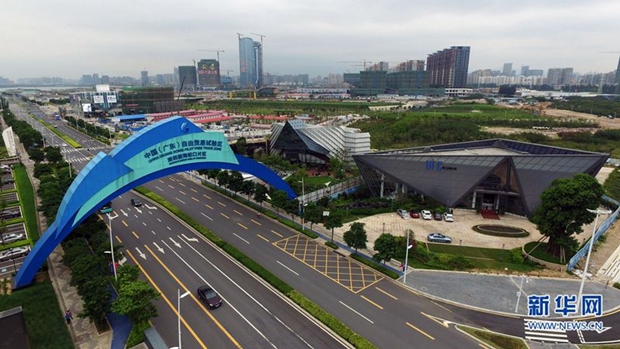Domestic and global implications of China's economic restructuring and upgrading
- By Chi Fulin
 0 Comment(s)
0 Comment(s) Print
Print E-mail China.org.cn, November 29, 2017
E-mail China.org.cn, November 29, 2017
Editor's Note: Chi Fulin, president of the China Institute for Reform and Development, addressed a recent international symposium on the theme of "Grasping the New Era of China's Development" in Beijing. The following was a piece of translation from his original speech.

The restructuring and upgrading of the world's second-largest economy bears significance for both China and the world. [Xinhua]
The primary goal of China's recent economic restructuring should be transition from rapid growth to high-quality development and the establishment of a modern economic system.
China's economic restructuring and upgrading has reached a historic juncture
With nearly four decades of reform and development, China has generally entered an advanced stage of industrialization.
Firstly, the service sector is rising to prominence in the industrial structure. The service sector accounted for 52.9 percent of GDP in the first three quarters of this year, and the proportion is predicted to approach or reach 60 percent by 2020.
Secondly, service consumption is establishing dominance in the consumption structure. The proportion of service consumption in urban areas is forecast to increase from about 40 percent to around 50 percent by 2020.
Thirdly, China is pursuing an urbanization of its population. It is predicted that the percentage of permanent urban residents will increase from 57.35 percent in 2016 to over 60 percent by 2020.
And fourthly, to advance its economic restructuring and upgrading, China needs to shift its emphasis away from trade in goods toward trade in services during the process of opening-up. The proportion of trade in services to foreign trade is predicted to rise from 18 percent in 2016 to over 30 percent by 2020.
China's economic restructuring and upgrading will bring about enormous potential for development and a broader market
To develop a modern economic system, China needs to foster new drivers and areas of growth while promoting economic restructuring and upgrading.
Upgrading the industrial structure will create pressure for the quality of the supply system to be improved. A preliminary estimate shows that the scale of China's service sector is likely to increase from 38.4 trillion yuan in 2016 to around 50 trillion yuan by 2020. This will optimize China's economic structure and generate huge room for new growth.
Optimizing the consumption structure will create new growth drivers. According to a preliminary estimate, the total retail sales of consumer goods will rise from 33 trillion yuan in 2016 to 50 trillion yuan in 2020.
Transforming the urban-rural structure will release tremendous potential of the rural market. In the coming five to ten years, the integrated development of urban and rural areas will generate investment and consumption demand worth nearly 100 trillion yuan, which is the "greatest dividend" for medium- and long-term development.
China's industrial transformation is fueling the economic restructuring and upgrading
The latest round of technological revolution on a global scale coincides with China's economic transformation and upgrading, bringing about a fresh driver propelling the development of a modern economic system.
The growth of the digital economy is accelerating the transformation and upgrading of manufacturing industries. A number of landmark achievements have been made in science and technology. New industries and business formats are flourishing. Digital technology is deeply integrated into the transformation of traditional manufacturing industries.
The growth of the digital economy is also speeding up innovation-driven development. The value of China's information consumption is estimated to reach 12 trillion yuan by 2025, and the value of e-commerce transactions about 67 trillion yuan. The industrial transformation oriented to the new economy will promote the transition of China's growth model from being reliant on resources to being driven by innovation and technology.
Despite profound and complex changes both at home and abroad in the past few years, China's GDP has risen from 54 trillion to 80 trillion yuan. This is attributable to its economic restructuring and upgrading. In the next five to ten years, the transformation and upgrading of industrial, consumption and urban-rural structures will deliver synergistic benefits. China's growth rate is expected to be at least 6 percent, and its contribution to the global economy to remain around 30 percent.
More importantly, economic transformation and upgrading can also improve the quality of economic growth. For example, the new growth model relies less on resources. According to a preliminary estimate, if the proportion of the service sector remains no less than 55 percent by 2020, the energy consumption rate will be reduced by 14 percent, and sulfur dioxide emissions by about 18 percent. In this way, China will pave a path of green development where economic restructuring and upgrading and environmental protection reinforce each other.
The economic restructuring and upgrading of the world's second-largest economy has significance both domestically and abroad. While promoting its own transformation and development, China is also contributing to the world's economic recovery and growth, injecting new vitality into global economic governance.
Chi Fulin is president of the China Institute for Reform and Development.
This article was translated by Zhang Liying. Its original version was published in Chinese.
Opinion articles reflect the views of their authors, not necessarily those of China.org.cn.






Go to Forum >>0 Comment(s)